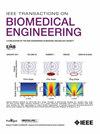Unpaired Dual-Modal Image Complementation Learning for Single-Modal Medical Image Segmentation
IF 4.4
2区 医学
Q2 ENGINEERING, BIOMEDICAL
引用次数: 0
Abstract
用于单模态医学图像分割的非配对双模态图像互补学习
目的:多模态 MR/CT 图像分割是疾病诊断和治疗中的一项重要任务,但在临床实践中,由于成本高昂和对造影剂的特殊过敏反应,通常很难获取患者的对齐多模态图像。为了解决这些问题,我们提出了一个任务互补框架,在训练阶段实现非配对多模态图像互补学习,在推理阶段实现单模态图像分割:方法:为了在训练阶段融合未配对的双模态图像,并在推理阶段进行单模态图像分割,我们构建了一个合成-分割任务互补网络,以相互促进跨模态图像合成和分割,因为相同的内容特征可用于执行图像分割任务和图像合成任务。为了保持形状各异的目标器官的一致性,提出了曲率一致性损失,以调整原始图像和跨模态合成图像的分割预测。为了分割小的病变或亚结构,利用目标器官的辅助特征构建了回归-分割任务互补网络:利用内部数据集和公开数据集进行了综合实验。实验结果表明,我们的框架优于最先进的方法:结论:提出的方法可以在训练阶段融合双模态 CT/MR 图像,在推理阶段只需要单模态 CT/MR 图像:意义:当患者只有单模态 CT/MR 图像时,所提出的方法可用于常规临床场合。
本文章由计算机程序翻译,如有差异,请以英文原文为准。
求助全文
约1分钟内获得全文
求助全文
来源期刊

IEEE Transactions on Biomedical Engineering
工程技术-工程:生物医学
CiteScore
9.40
自引率
4.30%
发文量
880
审稿时长
2.5 months
期刊介绍:
IEEE Transactions on Biomedical Engineering contains basic and applied papers dealing with biomedical engineering. Papers range from engineering development in methods and techniques with biomedical applications to experimental and clinical investigations with engineering contributions.
 求助内容:
求助内容: 应助结果提醒方式:
应助结果提醒方式:


